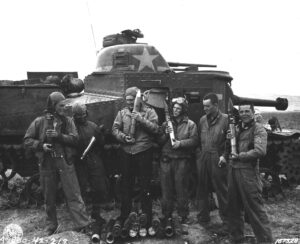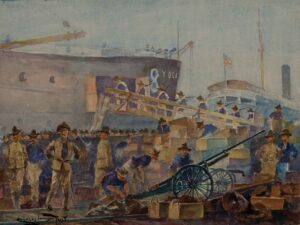Written By: Danny M. Johnson

During World War II, hundreds of thousands of American soldiers who deployed to Europe passed through Camp Myles Standish, Massachusetts. The camp was also a major installation for units returning to American soil for redeployment to the Pacific Theater of Operations or inactivation. In addition to using Camp Myles Standish as a staging area for the Boston Port of Embarkation (BPOE), the Army also employed the camp as a prisoner of war facility. Camp Myles Standish was named for Myles Standish (c. 1587-1656), an English-born professional soldier hired by the Pilgrims as military advisor for Plymouth colony. Eventually he became a full member of the colony as well as a valued leader of the community. Arriving on the Mayflower with the first settlers, he initially concentrated on colonial defense and Indian relations. Standish later represented Plymouth in England and then served for many years as one of the governor’s assistants and as the colony’s treasurer.

He was one of the founders of the town of Duxbury, Massachusetts. Although one of the most influential figures in colonial New England, he may be best remembered through poet Henry Longfellow’s “The Courtship of Miles Standish,” written in 1863. Construction of the camp commenced in 1942 after the Army acquired 1578.21 acres of farmland around Taunton, Massachusetts, at a cost of $13 million. It was a huge, sprawling collection of long, low, one-story tar-papered barracks, organized like an immense assembly line. The post was designed with a capacity for 1,298 officers and 23,100 enlisted personnel. The barracks measured about twenty by fifty feet in size, and each had a pot-bellied coal heater in the center of each building.
The New Haven Railroad had a switching yard (totaling about ten miles of track) at Camp Myles Standish. The New Haven was responsible for troop train movements and freight/supply for the camp. None of the yard remains today. Camp Myles Standish is not to be confused with the earlier Fort Standish, located on Lovell’s Island, Massachusetts, that was also named in honor of Myles Standish. That facility is now part of Boston Harbor Islands State Park. Camp Myles Standish was just one of many Army bases located in the Boston area. BPOE was the site where troops were actually put on board troop ships and sent off to the war zones. On the New Haven Railroad side, the actual port of embarkation was located at the Boston Army Base on the South Boston waterfront. The BPOE was a sub port of the New York Port of Embarkation until July 1942. Some 768,898 military and civilian personnel including enemy POWs embarked at Boston from 1942 through December 1945.
Loudspeakers warned troops as soon as they detrained at Camp Myles Standish that “this was a secret station, no telegrams, no mention of this camp at all.” Soldiers had to hike from the train station to the barracks situated about a mile away. In the weeks that followed processing of clothing and equipment, a full round of lectures occupied all hands so they were advised about ship security, censorship, finance, sanitation, conduct overseas and other pertinent subjects (including “gangplank fever”). There were movies on venereal disease and on maintaining secrecy.
Soldiers marched to the on-post lake, where they were instructed in the correct method of abandoning ship and living in a lifeboat. Physical fitness was maintained through road marches, obstacle course running, and athletic contests. Soldiers marched from lectures to movies, to the infirmary, and to the mess hall. Inspection teams went through the barracks, checking equipment and issuing missing items. Weapons were checked. Soldiers turned in their khaki uniforms and donned the olive drab uniform. Each man received a sweater, wool socks, towels, and new lightweight gas masks. Next was a round of lectures on poison gas, war bond allotments, and other subjects, followed by immunization shots against typhus, tetanus, and typhoid.

After the day’s processing, there was more training. Soldiers ate in giant mess halls, which fed more than 1,500 men three times a day. Theaters, phone booths, and service clubs were packed. Nearby families invited some soldiers to their homes for holidays or a Sunday meal. Occasionally there would be an ice skating party on a local pond. Once a week, several buses filled with young women and ever present chaperones would take ladies to dances at Camp Myles Standish.
When available, big-name bands on their way overseas to entertain the troops would play at the dances. Soldiers were also allowed to go into Boston on a 12-hour pass. Last minute censored phone calls were made to wives, folks, family members, and sweethearts. Many phone calls followed a familiar pattern: “No mom, I can’t tell you where I’m at or what I’m doing, but please don’t worry about me.” Mail that left the camp was censored, in most cases for the first time, for soldiers pending departure for overseas.
Shortly before departing the camp for overseas deployment, soldiers received orders to pack their duffel bags and field packs. With music provided by the camp band, soldiers left Camp Myles Standish aboard a New Haven Railroad troop train. After loading onto the train, the soldiers were told to keep the window shades pulled down. It did not take long to travel the thirty-five miles to Boston Harbor. The train took soldiers right down to the pier. As soldiers piled out of the train coaches and marched towards the gangplanks, often to accompaniment of martial music, Red Cross volunteers passed out hot coffee, doughnuts, and chocolate bars.
By 1945, the embarkation process was largely reversed. Towards the end of World War II, Camp Myles Standish became a redeployment and inactivation site for Army forces returning to the United States from Europe. Ships pulled into the Port of Boston at all times of the day and night. Troop ships carrying various units pulled up to the pier to disembark. The personnel loaded directly on to railroad cars from the boat for the trip back to the camp. Soldiers were assigned quarters upon arriving at the camp. Each living area featured tailor shops and well stocked post exchanges.
On the following day, matters of physical check-ups, personnel records, and pay were swiftly taken care of. Soldiers were then assembled at the post theater for a short orientation on discharge procedures. The men were divided into groups according to the location of separation center where they would be discharged from the Army. As soldiers were discharged or transferred to other organizations, the units shrank rapidly in size. The Adjutant General published orders announcing units which would be inactivated.
The last morning reports would be prepared and the unit colors would be packed for shipment to the Army’s flag repository in Indianapolis. Most of the time there was no inactivation ceremony, for there was no one left in the units. The largest organization inactivated at Camp Myles Standish was Headquarters and Headquarters Company, Fifth Army, in October 1945. Camp Myles Standish was closed as a military facility on 7 January 1946. The land was briefly considered as a potential site for the United Nations. Following its closure, the military camp was purchased by the Massachusetts Department of Mental Health and converted to the Myles Standish State School, which housed up to 3,000 patients with various degrees of mental handicaps.
The 1,400 bed post hospital was one reason that the school was established here. Most of the military buildings were demolished or deteriorated over time. New brick buildings were erected for use by the new school around 1951. The old hospital area was near the current Pepsi plant in the Myles Standish Industrial Park. The school’s name changed in 1959 when it took on the name of former Massachusetts Governor Paul A. Dever (1903-1958). Presently, about 700 acres, or three-quarters of the former Army post, has been converted to the Myles Standish Industrial Park. Some land has been reserved for open space and water protection. The Paul A. Dever State School consisted of thirteen L-shaped dormitory buildings, as well as centrally located kitchens and other mixed use structures. In more recent years, the school suffered from financial problems which led to a series of lawsuits. As a result, much of the facility closed in 1991, and the entire center was shut down in 2002.



